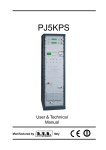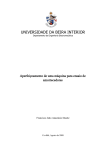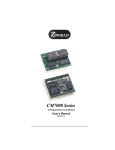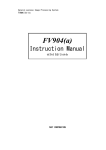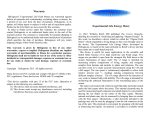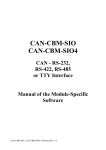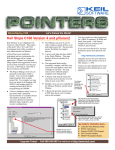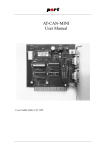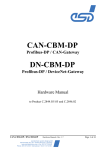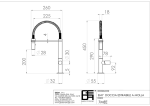Download CAN - CAI812
Transcript
CAN - CAI812 8 Analog Inputs 12 Bit Resolution Hardware Manual CAN-CAI812 Hardware Rev. 5.1 NOTE The information in this document has been carefully checked and is believed to be entirely reliable. esd makes no warranty of any kind with regard to the material in this document, and assumes no responsibility for any errors that may appear in this document. esd reserves the right to make changes without notice to this, or any of its products, to improve reliability, performance or design. esd assumes no responsibility for the use of any circuitry other than circuitry which is part of a product of esd gmbh. esd does not convey to the purchaser of the product described herein any license under the patent rights of esd gmbh nor the rights of others. esd electronic system design gmbh Vahrenwalder Str. 205 D-30165 Hannover Germany Tel: Fax: Email: +49-511-372-980 +49-511-633-650 [email protected] CAN-CAI812 Hardware Rev. 5.1 Manual File: I:\TEXTE\DOKU\MANUALS\CAN\CAI812\CAI8251H.EN6 Date of Print: 24.11.97 Described PCB Version: CAI812-4 Changes in the Chapters The changes in the user’s manual listed below affect changes in the hardware, as well as changes in the description of the facts only. Manual rev. Chapter Changes with respect to Rev. 5.0 - First english issue. - - 5.1 Further technical changes are subject to change without notice. CAN-CAI812 Hardware Rev. 5.1 CAN-CAI812 Hardware Rev. 5.1 Content Page 1. Functional Characteristics . . . . . . . . . . . . . . . . . . . . . . . . . . . . . . . . . . . . . . . . . . . . . . . . . . . . . 3 1.1 Overview . . . . . . . . . . . . . . . . . . . . . . . . . . . . . . . . . . . . . . . . . . . . . . . . . . . . . . . . . . . . . 3 1.1.1 Description of the Module . . . . . . . . . . . . . . . . . . . . . . . . . . . . . . . . . . . . . . . . 3 1.1.2 Case View with LED and Connector Description . . . . . . . . . . . . . . . . . . . . . . 5 1.1.3 General Technical Data . . . . . . . . . . . . . . . . . . . . . . . . . . . . . . . . . . . . . . . . . . 6 1.1.4 CAN- and µController Assemblies . . . . . . . . . . . . . . . . . . . . . . . . . . . . . . . . . . 7 1.1.5 EMY-OFF Input, Message Outputs . . . . . . . . . . . . . . . . . . . . . . . . . . . . . . . . . 8 1.1.6 A/D-Converter Assemblies . . . . . . . . . . . . . . . . . . . . . . . . . . . . . . . . . . . . . . . . 9 1.1.7 Software Support . . . . . . . . . . . . . . . . . . . . . . . . . . . . . . . . . . . . . . . . . . . . . . . 9 1.2 Order Information . . . . . . . . . . . . . . . . . . . . . . . . . . . . . . . . . . . . . . . . . . . . . . . . . . . . . 10 2. General Installation Notes . . . . . . . . . . . . . . . . . . . . . . . . . . . . . . . . . . . . . . . . . . . . . . . . . . . . . 2.1 Installation and Fastening of the Module . . . . . . . . . . . . . . . . . . . . . . . . . . . . . . . . . . . 2.2 Installation of Connectors and Cables . . . . . . . . . . . . . . . . . . . . . . . . . . . . . . . . . . . . . . 2.2.1 Supply Voltage, EMY OFF, Message Input and Earth Terminal (P1, P5) . . . 2.2.2 CAN Connections P2, P3 . . . . . . . . . . . . . . . . . . . . . . . . . . . . . . . . . . . . . . . . 2.2.3 I/O Connector P4 . . . . . . . . . . . . . . . . . . . . . . . . . . . . . . . . . . . . . . . . . . . . . . 11 11 12 12 14 15 3. Bridges and Coding Switches . . . . . . . . . . . . . . . . . . . . . . . . . . . . . . . . . . . . . . . . . . . . . . . . . . 17 3.1 Default Setting of Bridges and Coding Switches . . . . . . . . . . . . . . . . . . . . . . . . . . . . . 19 3.2 Bridges and Coding Switches of CAN Assemblies . . . . . . . . . . . . . . . . . . . . . . . . . . . . 20 3.2.1 Use of other 'Physical Layers' (BR1, BR2) . . . . . . . . . . . . . . . . . . . . . . . . . . 20 3.2.2 Configuration field (J3) . . . . . . . . . . . . . . . . . . . . . . . . . . . . . . . . . . . . . . . . . 21 3.2.3 CAN-Identifier Bits id11...id4 (SW0, SW1) . . . . . . . . . . . . . . . . . . . . . . . . . 23 3.2.4 Bridges and Coding Switches of the Analog Inputs . . . . . . . . . . . . . . . . . . . 24 3.2.4.1 Selection of Channels for Current Measurement (J4...J18) . . . . . . . 24 3.2.4.2 Selection of the Measuring Area (J5...J19) . . . . . . . . . . . . . . . . . . . 25 3.2.4.3 Bridging the Potential Divider and the Second Input Filters (J401...J504) . . . . . . . . . . . . . . . . . . . . . . . . . . . . . . . . . . . . . . . . . . . 26 4. CAN Identifiers . . . . . . . . . . . . . . . . . . . . . . . . . . . . . . . . . . . . . . . . . . . . . . . . . . . . . . . . . . . . . 27 5. Description of the Assemblies . . . . . . . . . . . . . . . . . . . . . . . . . . . . . . . . . . . . . . . . . . . . . . . . . . 5.1 CAN Interface . . . . . . . . . . . . . . . . . . . . . . . . . . . . . . . . . . . . . . . . . . . . . . . . . . . . . . . . 5.1.1 Bitrate . . . . . . . . . . . . . . . . . . . . . . . . . . . . . . . . . . . . . . . . . . . . . . . . . . . . . . . 5.1.2 Transmit and Receive Circuit of the CAN Interface (Physical Layer) . . . . . . 5.1.3 Use of other Physical Layers (Add-On Option) . . . . . . . . . . . . . . . . . . . . . . . 5.2 EMY-OFF Input and Message Outputs . . . . . . . . . . . . . . . . . . . . . . . . . . . . . . . . . . . . . 5.2.1 EMY-OFF Input . . . . . . . . . . . . . . . . . . . . . . . . . . . . . . . . . . . . . . . . . . . . . . . 5.2.2 Message Outputs . . . . . . . . . . . . . . . . . . . . . . . . . . . . . . . . . . . . . . . . . . . . . . . 5.3 Analog Inputs . . . . . . . . . . . . . . . . . . . . . . . . . . . . . . . . . . . . . . . . . . . . . . . . . . . . . . . . . 5.3.1 Input Circuit . . . . . . . . . . . . . . . . . . . . . . . . . . . . . . . . . . . . . . . . . . . . . . . . . . 5.3.2 Balancing the Analog Inputs . . . . . . . . . . . . . . . . . . . . . . . . . . . . . . . . . . . . . . 5.4 LED Displays . . . . . . . . . . . . . . . . . . . . . . . . . . . . . . . . . . . . . . . . . . . . . . . . . . . . . . . . . 5.4.1 Status LED (LED 1) . . . . . . . . . . . . . . . . . . . . . . . . . . . . . . . . . . . . . . . . . . . . 29 29 29 29 31 33 33 34 35 35 36 37 37 6. Appendix . . . . . . . . . . . . . . . . . . . . . . . . . . . . . . . . . . . . . . . . . . . . . . . . . . . . . . . . . . . . . . . . . . . 39 CAN-CAI812 Hardware Rev. 5.1 1 Content Page 6.1 Connector Assignments . . . . . . . . . . . . . . . . . . . . . . . . . . . . . . . . . . . . . . . . . . . . . . . . . 6.1.1 Voltage Supply and 'EMY OFF' P1 . . . . . . . . . . . . . . . . . . . . . . . . . . . . . . . . 6.1.2 I/O Connectors P4 (MSTB/2.5 40-pin) . . . . . . . . . . . . . . . . . . . . . . . . . . . . . . 6.1.3 CAN Connector P2 (9-pin DSUB male) . . . . . . . . . . . . . . . . . . . . . . . . . . . . . 6.1.4 CAN Connector P3 (9-pin DSUB female) . . . . . . . . . . . . . . . . . . . . . . . . . . . 6.1.5 Add-On Male Connector X8 (optional) . . . . . . . . . . . . . . . . . . . . . . . . . . . . . 6.1.6 Add-On Male Connector X7 (optional) . . . . . . . . . . . . . . . . . . . . . . . . . . . . . 6.2 Circuit Diagrams . . . . . . . . . . . . . . . . . . . . . . . . . . . . . . . . . . . . . . . . . . . . . . . . . . . . . . 6.3 Data Sheets . . . . . . . . . . . . . . . . . . . . . . . . . . . . . . . . . . . . . . . . . . . . . . . . . . . . . . . . . . 2 39 39 41 42 43 44 45 47 49 CAN-CAI812 Hardware Rev. 5.1 Overview 1. Functional Characteristics 1.1 Overview 1.1.1 Description of the Module e le c tr ic a l is o la tio n P 2 C C h a n n e l 1 A N P h y s ic a l C A N L a y e r P 3 B J 4 S h u n t - P 1 P o w e r S u p p ly In p u t: 2 4 V (D C ) O u tp u t: 5 V (D C ) C A N W a tc h d o g I/O Id e n tifie r µ C 8 0 C 5 9 2 d ig ita l I/O P o rts 8 C h a n n e l 1 2 B it A /D L T C 1 2 9 4 C h a n n e l 8 d ig ita l P o rts + J 1 8 - E P R O M P 4 E m e rg e n c y S to p a n d M e s s a g e O u tp u t T e r m in a l B lo c k S T e r m in a l B lo c k U + 2 5 6 B y te R A M S h u n t e x te rn a l S R A M J 3 Fig. 1.1.1: Functional block diagram of the CAI812 The CAI812 module offers 8 differential analog inputs with a 12-bit resolution. The input-voltage area can be selected via jumpers separately for each channel between ±5 V and ±10 V. Furthermore the module can be configurated via jumpers channel-by-channel for current measurement (±20 mA, ±40 mA). By means of the software it is possible to select whether the input signals are to be evaluated bipolarly or unipolarly. The analog inputs are evaluated by means of the A/D converter LTC1294, which is galvanically isolated from the CAN assemblies. The firmware offers the possibility to let the user select zero point and measuring area of the individual channels. The physical CAN layer is galvanically isolated from the other local assemblies and is designed according to ISO 11898 for a bitrate of 1Mbit/s. Other physical layers are optionally realizable via mountable piggyback. CAN-CAI812 Hardware Rev. 5.1 3 Overview The bitrate can be altered via jumpers on the PCB or configurated via the CAN. The CAN identifiers of the module can be set via two externally accessible rotary switches or they can also be configurated via the CAN. A dichromatic LED signalizes the total-system status of the module. Additional monitoring functions increase the reliability: After the watchdog time has elapsed, the watchdog timer, integrated into the µcontroller automatically triggers a RESET of the CAN module. Via the potential-free EMY-OFF input and the relay-message output the module becomes part of an EMY-OFF chain. 4 CAN-CAI812 Hardware Rev. 5.1 Overview 1.1.2 Case View with LED and Connector Description D IP s w itc h e s : L E D 1 (re d /g re e n ): P 2 a n d P 3 : P 1 : s e ttin g n o . a n d v a lu e o id e n tifie b o a rd s ta tu s : C A N c o n n e c to rs c o n n e c tin g o f 2 4 V p o w e r s u p p ly , e m e r g e n c y s to p in p u t a n d m e s s a g e o u tp u ts o f th th e f th e r b is e m o d u le d e fa u lt C A N id 1 ... id 8 L E D lig h ts g r e e n - n o e r r o r L E D lig h ts r e d - e r r o r o n b o a r d L E D o ff - p o w e r s u p p ly fa ile d G N D H IG H S ta tu s L O W P 3 P 2 D S U B 9 /fe m a le D S U B 9 /m a le E S - E S + + 2 4 V P 1 2 4 V /E S / m e s s a g e o u tp u t C A N B U S M o d u le - Id : C A I8 1 2 8 a n a lo g in p u ts 1 2 3 4 5 6 7 in s c r ip tio n fie ld s 8 1 7 1 P 4 3 2 1 6 P E P 5 : P 5 P E te r m in a l c o n n e c te d to m e ta llic c a s e P 4 : I/O CAN-CAI812 Hardware Rev. 5.1 c o n n e c to r 5 Overview 6 CAN-CAI812 Hardware Rev. 5.1 Overview 1.1.3 General Technical Data Temperature area permissible ambient temperature: 0...50 (C Humidity max. 90%, not condensing Operating voltage nominal voltage 24 V ±10 %, current input (typical, at 20 (C): 300 mA, electronic reverse-battery protection, safety fuse 400 mA/T Connectors P1 (MSTB/2.5) - supply voltage, EMY-OFF input, message output, P2 (DSUB9/male) - CAN connection P3 (DSUB9/female) - CAN connection P4 (screw/clip connector MSTB/2.5) - analog inputs P5 (KDS/4) - designed for earthing the case top Case Dimensions: 136 x 66 x 245 mm, installable on rails NS35/7.5 DIN EN 50022 (space between rails 150 mm) Weight ca. 700 g Table 1.1.1: General data of the CAI812 CAN-CAI812 Hardware Rev. 5.1 7 Overview 1.1.4 CAN- and µController Assemblies CAN interface physical layer according to ISO 11898, add-on option for other physical interfaces Transmission rate selectable via jumpers or programmable from 10 kbit/s to 1 Mbit/s CAN identifiers can be set via coding switches and are programmable via the CAN, the module assigns 2 Tx identifiers esd-module no. Can be set via coding switches and programmed via CAN µcontroller 8xC592, 16 MHz EPROM for storing the firmware, memory capacity 32 kbytes EEPROM for storing the CAN parameters SRAM memory capacity 32 kbytes LED display dichromatic LED for displaying the status of the µcontroller Galvanical isolation of the CAN interface from µcontroller assemblies according to German VDE regulation 0110b§8, isolation group C and installation into cubicle: 300 VDC / 250 VAC Table 1.1.2: Technical data of the CAN- and µcontroller assemblies 8 CAN-CAI812 Hardware Rev. 5.1 Overview 1.1.5 EMY-OFF Input, Message Outputs EMY-OFF input Nominal voltage 24 V, reverse-battery protected Activation EMY OFF is triggered, if the input is dead, activation triggers local RESET Galvanical isolation input isolated from µcontroller assemblies via optocoupler Message outputs Number 1 break contact, 1 make contact Activation total-system status OK -> message outputs activated (breaker open, maker closed) Switching voltage (DC) 1 mV...100 V DC Load capacity (DC) switching current area: make current: steady current: interrupting current: 1 µA... 1 A max. 5 A max. 2 A max. 1 A Table 1.1.3: Technical data of the EMY-OFF input and the message outputs CAN-CAI812 Hardware Rev. 5.1 9 Overview 1.1.6 A/D-Converter Assemblies Number Resolution, accuracy 8 inputs resolution of the converter: linearity and accuracy of the converter: 12 bit ±1 LSB measuring-value display on the CAN: straight binary, normalized to 16 bit $7FFF...$0000...$8000 ± $0004 range of values on the CAN: tolerance of measuring value: Common mode voltage area ±5 V: voltage area ±10 V: common mode ±8 V common mode ±3 V selectable via jumpers: Measuring area -5 V...+5 V, (-20 mA...+20 mA) -10 V...+10 V furthermore selectable via software: bipolar or unipolar measuring area (with 12-bit resolution each) Input resistance voltage input: 1 M$ current input: 250 $/1‰ Supply voltage of the analog assemblies locally generated from the +24 V supply from the CAN module via DC/DC converters Potential separation from µcontroller assemblies Galvanical isolation (according to German VDE regulation 0110b §8, isolation group C and installation into cubicle): 300 V(DC) / 250 V(AC) Table 1.1.4: Technical data of the analog inputs 1.1.7 Software Support The complete EPROM-resident CAN-communication firmware required to operate the module is contained in the delivery. (see software manual of the module.) 10 CAN-CAI812 Hardware Rev. 5.1 Order Information 1.2 Order Information Type Properties Order no. CAN-CAI812 CAN module with 8 analog inputs, 12-bit resolution C.2702.02 CAN-CAI812-MD (*) user's manual in German C.2702.20 CAN-CAI812-ME (*) user's manual in English C.2702.21 (*) The manual is included in the price, if ordered together with the module. Table 1.2.1: Order information CAN-CAI812 Hardware Rev. 5.1 11 12 CAN-CAI812 Hardware Rev. 5.1 Installation 2. General Installation Notes 2.1 Installation and Fastening of the Module The esd-CAN modules are flat assemblies which are designed for the installation into cubicles. They can be installed on two rails (NS 35/7.5 DIN EN 50022, space 150 mm) next to each other. It is important to consider the free spaces above and below the case, as these are needed for the installation of connectors and cables and for latching the module case on the rails. The dimensions and the required installation space of the CAN module can be taken from the following figure. 1 1 1 ,5 1 3 6 2 0 5 2 8 5 c a r r ie r r a il m o u n tin g N S 3 5 /7 ,5 a c c . to D IN E N 5 0 0 2 2 o 4 ,5 2 0 6 6 2 4 0 ,5 2 4 5 2 4 ,5 5 5 2 0 1 7 ,5 (All dimensions in [mm].) Fig.2.1.1: Dimensions and required installation space of the module case CAN-CAI812 Hardware Rev. 5.1 13 Installation If possible, the modules are to be installed with the CAN connectors on top, since possible LED displays in the case can then be read much more comfortable. 2.2 Installation of Connectors and Cables P3 P4 P2 P1 P5 Fig. 2.2.1: Position of externally reachable connectors of the CAN module 2.2.1 Supply Voltage, EMY OFF, Message Input and Earth Terminal (P1, P5) The module is supplied with voltage via connector P1. The nominal value of the supply voltage is 24 VDC. The EMY-OFF input and the message output of the module are also at P1. The message output can be connected optionally. The EMY-OFF inputs must be supplied with voltage, otherwise the module cannot operate. If the inputs are open, the module is in 'RESET' status. 14 CAN-CAI812 Hardware Rev. 5.1 Installation If the EMY-OFF inputs should not be used, it is advisable to make bridges to the terminals of the module-voltage supply, which is next to the inputs, in order to enable these. V c c = + 2 4 V /D C E m e rg e n c y S to p In p u t M o d u le S ta tu s L E D G N D S W 2 H ig h S W 1 L o w Fig. 2.2.2: D S U B 9 F e m a le P 3 D S U B 9 M a le P 2 G N D E S - E S - E S + + 2 4 V + 2 4 V E S + M e s s a g e O u tp u ts P 1 Connection of the supply voltage and the EMY-OFF input signal (example: EMY-OFF function not in use) Via the EMY-OFF inputs the module can be integrated into an EMY-OFF chain (see fig. 2.2.3). Wires with a cross section of up to 2.5 mm can be connected to connector P1 (type: MDSTBW/2.5) via a strippable screwed connector (type: MSTB/2.5). Detailed descriptions about connector P1 can be taken from the appendix. CAN-CAI812 Hardware Rev. 5.1 15 Installation E S - E m e r g e n c y S to p C h a in E S + E S + E S - 4 4 3 P 1 P 1 P 1 M o d u le 2 3 1 2 1 1 1 2 1 1 1 2 1 1 M o d u le 1 4 3 M o d u le 3 Fig. 2.2.3: Integration of the module into an EMY-OFF chain The earth terminal P5 (type: KDS4) is connected to the plain connector P6 which is inside the case (see component diagram of the PCB). The earth cable of the case top is also connected to P6, therefore making it possible to connect the case top of the module to the protection earth (PE) via the screwed connector P5. The bottom of the module, however, is not connected to P5 or P6! It is earthed by screwing the protective conductor to a mounting hole via a cable terminal and toothed disks. Wires with a cross section of up to 4 mm² can be connected to the screwed connector P5. 2.2.2 CAN Connections P2, P3 The CAN is connected via connector P2 (male) or/and P3 (female). In their assignment both 9-pin DSUB connectors correspond to the recommendations of the CiA-Group (CAN in Automation, 11.1992). Detailed descriptions about these connectors can be taken from the appendix. The CAN cable has to be terminated at both ends. For this two 9-pin DSUB connectors with terminal resistors are available. 16 CAN-CAI812 Hardware Rev. 5.1 Installation 2.2.3 I/O Connector P4 Via P4 the analog inputs are connected. Three terminals have been designed for each of the 8 differential inputs: Ix+, Ix- and GND. Wires with a cross section of up to 2.5 mm² can be connected to the screw terminal P4 (type: MSTB/2.5). The screwed connections are pluggable in groups. Following display shows the top view of the screw terminal with the position of the individual connections. in te r n a l c o n n e c tio n s to c a s e c o v e r I1 + I1 - I2 + I2 - I3 + I3 - I4 + I4 - I5 + I5 - I6 + I6 - I7 + I7 - I8 + I8 1 7 G N D 1 3 2 1 6 P 5 P 4 P E e .g . -1 0 V ...+ 1 0 V + e .g . -5 V ...+ 5 V - + - Fig. 2.2.4: Connection of the analog inputs to P4 CAN-CAI812 Hardware Rev. 5.1 17 18 CAN-CAI812 Hardware Rev. 5.1 Jumper Assignment 3. Bridges and Coding Switches Fig. 3.1.1: Position of the coding switches and the bridges on the component layer of the PCB CAN-CAI812 Hardware Rev. 5.1 19 Jumper Assignment Fig. 3.1.2: Position of the solder bridges on the bottom layer 20 CAN-CAI812 Hardware Rev. 5.1 Jumper Assignment 3.1 Default Setting of Bridges and Coding Switches The respective default setting (see following table) as factory-set is registered. The arrangement of bridges and coding switches on the component layer can be taken from figure 3.1.1. In the following the bridges are shown as seen by the user when the PCB is viewed with the CAN connectors to the left. The arrangement of bridges on the bottom layer can be taken from figure 3.1.2. In the following the soldering bridges are shown as seen by the user when the PCB is viewed with the CAN connectors to the right. Bridge/ coding switch Function Setting piggyback connection for other physical layers standard according to ISO 11898 configuration bit rate 125 kbit/s J4, J6, ... ...J16, J18 current measurement channels 1 to 8 open, i.e. all inputs are configurated to measure voltage J5, J7, ... ...J17, J19 setting the measuring area channels 1 to 8 jumpered, i.e the measuring area is set to ±10 V for all channels J401, J402,... ...J503, J504 bridging the potential dividers of the input circuits potential dividers and filters are not bridged coding switches SW0 - LOW SW1 - HIGH CAN-identifier bits id4-id11 user-dependent BR1, BR2 J3 Table 3.1.1: Default setting of bridges and coding switches CAN-CAI812 Hardware Rev. 5.1 21 Jumper Assignment 3.2 Bridges and Coding Switches of CAN Assemblies 3.2.1 Use of other 'Physical Layers' (BR1, BR2) If other physical interfaces are to be used, the module can be equipped with an ADD-ON. If the module already has the CAN driver 82C250 or Si9200 and another interface should be used, the CAN connectors have to be separated from the driver. This is achieved by removing thin conductor lines between the pads of soldering bridge BR1. If required, the connections can be established again by soldering the pads. The soldering bridge is on the bottom layer of the PCB near to the CAN connectors. Furthermore the Rx output of optocoupler U3 has to be separated from the interface, since the coupler sets its outputs also with open input. This is avoided by separating the thin conductor line between the pads of soldering bridge BR2. If required, this connection, too, can be established again by soldering the pads of the bridge. BR2 can be found on the component layer of the PCB next to optocoupler U3 of the CAN interface. # *1'*1' &$1B/&$1B+ (View of bottom layer/CAN connectors to the right) # &5[IURP8+&3/ (View of component layer/CAN connectors to the left) Standard setting: All bridges are connected. 22 CAN-CAI812 Hardware Rev. 5.1 Jumper Assignment 3.2.2 Configuration field (J3) Jumper Function Bit *33, 16 o o 15 D7 mode o o D6 oo D5 bitrate oo D4 J3 o o D3 o o D2 CAN-identifier bit id11 o o D1 CAN-identifier bit id10 2 o o 1 D0 CAN-identifier bit id9 jumper set -- bit = '1'! Function of bits: Mode (D7): Only for esd-internal use: jumper open ... normal mode jumper set ... test mode CAN-CAI812 Hardware Rev. 5.1 23 Jumper Assignment Bitrate (D6-D3): Transmission speed A jumper here sets the according bit to the value '1'! The specified typical line lengths base on experimental values from practice. The minimum reachable line lengths result from the 'worst case' delay of the components used. The default setting of the module as factory-set is shown in bold print. Jumper bits 8xC592 register D6 D5 D4 D3 0 0 0 0 0 0 0 0 1 1 1 1 1 1 1 0 0 0 0 1 1 1 1 0 0 0 0 1 1 1 0 0 1 1 0 0 1 1 0 0 1 1 0 0 1 BTR0 [HEX] BTR1 [HEX] 00 00 00 01 01 02 03 04 45 09 4B 18 5F 31 00 14 18 1C 18 1C 1C 1C 1C 2F 1C 2F 1C 2F 1C 16 0 1 0 1 0 1 0 1 0 1 0 1 0 1 0 Bitrate [kbit/s] typical values of the reachable line length lmax [m] 1000 666.6 500 333.3 250 166 125 100 66.6 50 33.3 20 12.5 10 800 37 80 130 180 270 420 570 710 1000 1400 2000 3600 5400 7300 59 minimum reachable line length lmin [m] 20 65 110 160 250 400 550 700 980 1400 2000 3600 5400 7300 42 The specifications in the table base on the limit values of the bit timing of the CAN protocol, the delay times of the local CAN interface and the delay times of the cable. This is assumed with about 5.5 ns/m. Further influences, as caused for instance by missing terminal resistors, the specific resistance, the cable geometry or external disturbances, have not been considered for the transmission! Table 3.2.1: Setting the transmission speed via J3 CAN-Identifier Bits id9 to id11: D0 = id9 D1 = id10 D2 = id11 jumpered -- bit = '1' 24 CAN-CAI812 Hardware Rev. 5.1 Jumper Assignment 3.2.3 CAN-Identifier Bits id11...id4 (SW0, SW1) Via the coding switches 'HIGH'(SW1) and 'LOW'(SW0) the default values of the CAN-identifier bits id1 to id8 are set. Furthermore the value set at the coding switches corresponds to the esd-module no. (see software manual of the module). Setting: $00...$FF Switch *) HIGH (SW1) LOW (SW0) Bit 7 6 5 4 3 2 1 0 Function id8 id7 id6 id5 id4 id3 id2 id1 *) The setting of identifier bit id1 is not evaluated on the CAI812. Id1 either selects channels 1-4 or 5-8. Table 3.2.2: Assignment of CAN-identifier bits id1 to id8 to the coding switches CAN-CAI812 Hardware Rev. 5.1 25 Jumper Assignment 3.2.4 Bridges and Coding Switches of the Analog Inputs 3.2.4.1 Selection of Channels for Current Measurement (J4...J18) Each input channel of the CAI812 has a jumper which enables a shunt of 250$/0.1% between the two inputs Ix+ and Ix- (x=1,2,...8). In order to configure the respective channel for measuring the current, the jumper has to be set. Standardly this jumper is open. The (electric) position of the jumper and the shunt in the input circuit can be taken from the circuit diagram in chapter 'Analog Inputs'. The assignment of channels to jumpers is shown in the table below: Channel of the CAI812 Jumper for current measurement 1 2 3 4 5 6 7 8 J4 J6 J8 J10 J12 J14 J16 J18 Table 3.2.3: Current-measurement assignment of channels to jumpers 26 CAN-CAI812 Hardware Rev. 5.1 Jumper Assignment 3.2.4.2 Selection of the Measuring Area (J5...J19) For each channel of the CAI812 the voltage (current) area to be evaluated can be selected via a jumper. If the jumper is open, input voltages in the area of ±5 V can be measured. If the jumper is set, the voltage-measuring area is ±10 V. Standardly all jumpers are set. The measuring area can only be selected via the jumpers J5...J19, if the jumpers J401...J504 (see following chapter) are set accordingly! Jumper J5...J19 open set default setting Measuring area voltage measurement*) -5 V...+5 V -10 V...+10 V Measuring area current measurement*) -20 mA...+20 mA -40 mA...+40 mA *) Jumpers J4..J18 are set according to current or voltage measurement. Table 3.2.4: Setting the measuring area via jumper J5...J19 Channel of the CAI812 Jumper for measuringarea setting 1 2 3 4 5 6 7 8 J5 J7 J9 J11 J13 J15 J17 J19 Table 3.2.5: Measuring-area assignment of channels to jumpers CAN-CAI812 Hardware Rev. 5.1 27 Jumper Assignment 3.2.4.3 Bridging the Potential Divider and the Second Input Filters (J401...J504) For each channel a jumper is available by means of which the potential divider, which is switched-on via jumpers J5, J7, ... and J19, can be bridged. Furthermore the following low pass of the instrument amplifier INA114 is bridged. The function of the jumper can also be taken from the figure in the chapter 'Input Circuit'. Jumper positions J401...J504 3 2 1 3 2 1 o o o Function potential divider is active (input voltage can be selected between ±5 V and ±10 V), filter circuit is active default setting o o o potential divider and filter are not active, input-voltage area is always ±5 V, jumper position of J5, J7,...J19 is unimportant Table 3.2.6 Function of jumpers J401...J504 Channel of the CAI812 Jumper for bridging the potential divider 1 2 3 4 5 6 7 8 J401 J402 J403 J404 J501 J502 J503 J504 Table 3.2.7: Bridging the input-potential divider - assignment of channels to jumpers 28 CAN-CAI812 Hardware Rev. 5.1 CAN Identifiers 4. CAN Identifiers In operation with the default parameters the CAN-Tx identifiers on the module consist of the following: id11 id10 id9 setting via jumper J3 id8 id7 id6 id5 setting via coding switch HIGH (SW1) id4 id3 are set by means of jumper J3 (1-2, 3-4, 5-6) id8-id2... are set via the coding switches SW0 and SW1 of the module id1... via id1 the channel group of the CAI812 is selected: id1 Tx identifier 1 to 4 0 TxId1 5 to 8 1 TxId2 id1 setting via coding switch LOW (SW0) id11-id9... Channel id2 A detailed description of the assignment of the jumper and the coding switches can be taken from the chapter 'Configuration Jumpers'. The local software of the module offers the possibility to program the Tx identifiers freely. Further information on this can be taken from the software manual of the esd-CAN protocol. CAN-CAI812 Hardware Rev. 5.1 29 30 CAN-CAI812 Hardware Rev. 5.1 CAN Interface 5. Description of the Assemblies 5.1 CAN Interface 5.1.1 Bitrate The transmission speed can be varied from 10 kbit/s to 1,0 Mbit/s. The bitrate is selected via J3. The local software of the module offers the possibility to reprogram the bitrate. This programmed bitrate then substitutes the bitrate set via J3. Further information on this can be taken from the software manual of the esd-CAN protocol. A detailed description of the possible bit rates can be taken from the description of jumper J3. 5.1.2 Transmit and Receive Circuit of the CAN Interface (Physical Layer) The physical interface of the esd CAN corresponds to the norm ISO 11898. The interface is connected to the busline via 9-pin DSUB connectors from which one is male and one is female. Other physical layers can optionally be realized by mountable piggyback. The Si9200or the 82C250, for instance, are used as CAN transceivers on the module. The voltage supply of the CAN is galvanically isolated from the fed 24V supply and the CAN controller 8xC592. The signals are galvanically isolated from the CAN by means of optocouplers. CAN-CAI812 Hardware Rev. 5.1 31 CAN Interface V C C X 7 c o n n e c to r p lu g s 1 x 1 0 ( o p tio n ) n .c . S D A G N D D C D C 2 S 7 U -0 5 0 5 + 5 V 5 V - C A N _ G N D - C A N _ G N D U 2 R N 3 1 0 K 2 T x 0 G N D V C C in U 4 S i9 2 0 0 / 8 2 C 2 5 0 O U T E N A B L E G N D in T X 0 + 2 4 V G N D V C C V C C R X 1 B R 2 G N D o u t U 3 O U T T X B U S L R X B U S H B R 1 G N D V C C in IN + 5 V V D D + 5 V H C P L 7 1 0 0 V C C o u t R x 0 C A N tr a n s c e iv e r C A N _ G N D C A N _ L X 8 1 0 - p o le c o n n e c to r p lu g s ( o p tio n ) 2 3 C A N _ H C A N _ G N D E N A B L E G N D o u t 6 V C C o u t IN T X 1 7 C A N _ G N D + 5 V H C P L 7 1 0 0 3 C A N _ L C A N _ H S C L R X 0 P 2 , P 3 9 - p o le D S U B + 5 V + 4 5 G N D in o p to c o u p le r s a d d - o n - o p tio n ( X 7 - X 8 ) fo r o th e r p h y s ic a l la y e r s +24 V, VCC, GND... TX0, RX0... TX1, RX1... SDA, SCL... Fig. 5.1.1: local supply voltages (galvanically isolated from the CAN interface) signals of CAN controller 8xC592 (U9), which are led onto the CAN (via available interface) signals of CAN controller 8xC592 for future applications (add-on) local serial bus (I²C), generated by the 8xC592 ports P1.1 (SDA) and P1.3 (SCL) Functional circuit diagram of the CAN interface in use with the interface components Si9200 or 82C250 The description of the connector assignment can be taken from the appendix. 32 CAN-CAI812 Hardware Rev. 5.1 CAN Interface 5.1.3 Use of other Physical Layers (Add-On Option) The CAN module offers the possibility to run the CAN with other physical layers. For this matter a PCB with the desired circuit can be mounted on an add-on plug-in. If the module is equipped with the CAN drivers 82C250 or Si9200, the CAN connectors have to be separated from the driver. This is achieved by removing thin conductor lines between the pads of bridge BR1. Furthermore the Rx output of the optocoupler U3 of the standard interface has to be separated, since the coupler also sets its output with open input. This can be avoided by separating the conductor line between the pads of bridge BR2. The add-ons are electrically connected via the optionally equipped wrap plugs X7 and X8. The pin assignment and description of these connectors can be taken from the chapter 'Connector Assignments', which can be found in the appendix. 1 2 X 7 6 .3 5 (2 5 0 ) o 2 .8 (1 1 0 ) 5 .0 8 (2 0 0 ) 9 X 8 1 1 .4 3 4 5 0 2 6 .6 7 (1 0 5 0 ) 2 9 .8 (1 1 7 0 ) 1 0 1 1 0 5 .0 8 (2 0 0 ) 1 0 .7 9 (4 2 5 ) 4 1 .2 8 (1 6 2 5 ) 4 6 .3 6 (1 8 2 5 ) 4 8 .9 (1 9 2 5 ) A ll d im e n s io n s in m m ( m il) . Fig. 5.1.2: Installation dimensions of the add-on (top view) CAN-CAI812 Hardware Rev. 5.1 33 CAN Interface Figure 5.1.2 shows the maximum permissible dimensions of the add-on. The free spaces above and below the add-on have to be considered when mounting the add-on. Since the dimensions of these free spaces depend on the size of the chosen PCB connectors, the user is responsible for keeping to the installation height. The wrap plugs X7 and X8 are mounted optionally. The size of the pins can vary depending on the design of the wrap plugs. The minimum size of the pins is 8 mm including the plastic socket. The pins of the wrap plugs have a square cross section of 0.635 mm². Two mounting holes are available for installing the add-on with 2.5 mm screws. 34 CAN-CAI812 Hardware Rev. 5.1 EMY-OFF Input and Message Outputs 5.2 EMY-OFF Input and Message Outputs 5.2.1 EMY-OFF Input The EMY-OFF input of the module is connected to the RESET input of controller 8xC592 via optocoupler U1 (TLP620). If the EMY-OFF input is dead at P1, the module is in 'RESET' status. This means that the connections EMY+ and EMY- have to be supplied with voltage on P1 for the operation of the module, even if the EMY-OFF option is not used. This can be achieved, e.g., by externally bridging pins 2 and 5 of the connector and the inputs. The nominal voltage of the EMY-OFF input is 24 V(DC) (between EMY+ and EMY-) for the operation of the module. The EMY-OFF input as well as the connections of the supply voltage cannot be polarized wrongly. F 1 F u s e P 1 + 2 4 V 1 C 1 1 1 u F R N 9 4 k 7 + 2 4 V U 1 T L P 6 2 0 2 R 1 4 4 k 7 E S + 3 , 1 1 to U 9 (8 x C 5 9 2 ) P in 1 5 E S 4 , 1 2 G N D (2 4 V ) 5 G N D (2 4 V ) 6 Fig. 5.2.1: Input circuit of the EMY-OFF input In chapter 'General Installation Notes' detailed displays of the wiring of the EMY-OFF input can be found. The description of the assignment of connector P1 can be taken from the appendix. CAN-CAI812 Hardware Rev. 5.1 35 EMY-OFF Input and Message Outputs 5.2.2 Message Outputs The module has two message outputs at P1, which are enabled by a relay. One output is connected to the maker and the second output is connected to breaker of the relay. The relay is driven via a 74HC14 component from port P35T1 (pin 30) of the controller 8xC592. P 1 p lu g - te r m in a l c o n n e c to rs R E L 3 0 R e la y T Q 2 -5 V 9 N C R E L S * fro m U 9 (8 x C 5 9 2 ) P o rt P 3 5 T I/ P in 3 0 V C C D 5 1 N 4 4 4 8 1 1 G N D U 1 5 7 4 H C 1 4 1 7 2 N C 4 9 7 1 0 3 8 8 1 0 Fig. 5.2.2: Circuit of the message outputs The description of the assignment of connector P1 can be taken from the appendix. 36 CAN-CAI812 Hardware Rev. 5.1 Analog Inputs 5.3 Analog Inputs 5.3.1 Input Circuit The input circuit of the CAI812 has been designed in a way that individually for each channels the desired voltage measuring area can be chosen via a jumper (J5...J19)(provided that J401...J504 are set accordingly). The input circuit has a shunt which can also be enabled via a jumper (J4...J18) and by which it is possible to measure current via the module. Depending on the jumper positions, following measuring areas are possible: -5 V ...+5 V (-20 mA ...+20 mA) -10 V ...+10 V (-40 mA ...+40 mA) The possible jumper positions have already been described in the chapter 'Selection of the Measuring Area (J5...J19)'. I/O P 4 c o n n e c to r R N 5 :A 1 0 0 K I1 + P in 1 7 R N 4 :A 1 M R N 4 :B 1 M I1 - C 4 1 0 0 p F C 1 5 1 0 0 p F U 5 IN A 1 1 4 J 4 2 1 S L 1 -2 R 2 2 5 0 R 0 ,1 % 3 C 1 7 1 0 n F R N 5 :B 1 0 0 K P in 1 8 J 4 0 1 S L 1 -3 3 2 1 + 1 5 V 2 + - 6 R 4 1 K 8 /0 ,1 % R 5 1 K 8 0 ,1 % - 1 5 V J 5 C 4 0 1 1 0 0 n F S L 1 -2 A D _ IN 1 to U 3 1 L T C 1 2 9 4 P in 1 2 1 P in 1 - 1 6 Fig. 5.3.1: Analog input circuit of the module (example: channel 1, ±10 V) Via the local software it is furthermore possible to configure the A/D converter LTC1294 for unipolar measurements. This makes measurements with 12-bit resolution in the areas of 0...+5 V (0...20 mA) and 0...+10 V (0...40 mA) possible. This configuration is described in the software manual of the module. CAN-CAI812 Hardware Rev. 5.1 37 Analog Inputs 5.3.2 Balancing the Analog Inputs The analog inputs can be balanced by the user by means of the firmware. This procedure is described in the manual 'CAN - CAI812 Manual of the Module-Specific Software’. 38 CAN-CAI812 Hardware Rev. 5.1 LED Displays 5.4 LED Displays 5.4.1 Status LED (LED 1) The status LED is between the coding switches and the CAN connector P3. In off-voltage status the LED is white, when run, however, it can luminesce in red or green. Following table shows the meaning of the different luminous states of the status LED. State of the status LED Status of the CAN module constantly green module status is OK, module runs with the parameters stored in the EEPROM. LED flashes: 250 ms green, 50 ms red module status is OK, module runs with the default parameters, because EEPROM data is defective or deleted. LED flashes: 40 ms green, 40 ms red current CAN error LED flashes: 50 ms green, 250 ms red The module found a temporary CAN error which however is not active anymore. constantly red Voltage supply is OK, all other functions of the module are out of order - µC 8xC592 is not working or an internal error has occurred. (In this case the user should contact the supplier who will then remove the error.) Table 5.4.1: Display of the status LED The position of the status LED on the module can also be taken from the figure in the chapter 'Case View with LED and Connector Description'. CAN-CAI812 Hardware Rev. 5.1 39 40 CAN-CAI812 Hardware Rev. 5.1 Connector Assignment 6. Appendix 6.1 Connector Assignments 6.1.1 Voltage Supply and 'EMY OFF' P1 internal assignment pin P1 row 1 (lower row) +24V +24V EMY+ EMY- GND GND *33333, 1 2 3 4 5 6 ! external connections +24V supply voltage ! ! 1 O O 'EMY OFF'key switch (optional) ! ! bridge for 'EMY OFF' ! GND of the supply voltage The 'EMY-OFF' input is inactive (no EMY OFF), if a voltage of 24 VDC is applied between the terminals 'EMY+' and EMY-'. For this either the supply voltage (see example above) or any other DC voltage can be used. The 'EMY-OFF' input is galvanically isolated from all other assemblies of the CAN module. If the voltage between the EMY inputs is disconnected (e.g. by key switch (breaker), a local RESET is triggered on the module. The RESET is maintained until voltage is applied to the EMY-OFF inputs again. The EMY-OFF inputs are always evaluated. The EMY-Off function cannot be blocked, that means that a voltage must always apply to the EMY-OFF inputs when the module is to be taken into operation! CAN-CAI812 Hardware Rev. 5.1 41 Connector Assignment The EMY-OFF input can be accessed by two male contacts each. Contacts 3 and 11 and contacts 4 and 12 are internally bridged. The construction of an EMY-OFF chain is shown in detail in the chapter 'General Installation Notes'. internal assignment pin P1 row 2 (upper row) relay relay EMY+ EMY- breaker maker *33333, 7 8 9 10 11 12 ! ! alarm supply device voltage for (e.g. horn) alarm device external connections (example) ! ! supply voltage for load relay load relay : breaker 42 CAN-CAI812 Hardware Rev. 5.1 Connector Assignment 6.1.2 I/O Connectors P4 (MSTB/2.5 40-pin) + Pin Signal Pin Signal *3!3, 1 17 I1+ GNDA 2 18 I1 GNDA 3 . 19 I2+ 4 . 20 I2 5 . 21 I3+ 6 . 22 I3 7 . 23 I4+ 8 . 24 I4 9 . 25 I5+ . 26 I5 10 . 27 I6+ 11 . 28 I6 12 . 29 I7+ 13 . 30 I7 14 . 31 I8+ 15 32 I8 GNDA 16 - Ix+, Ix-... differential analog inputs (x=1, 2, ...8) GNDA... reference potential Note: The permissible input-voltage area of a channel depends on the position of the according jumper (see section 'Selection of the Measuring Area') and the software parameterization (unipolar/bipolar)! CAN-CAI812 Hardware Rev. 5.1 43 Connector Assignment 6.1.3 CAN Connector P2 (9-pin DSUB male) 1 reserved 2 CAN_L 3 CAN_GND 4 reserved 5 reserved CAN_GND 6 CAN_H 7 reserved 8 reserved 9 Signal description: CAN_L, CAN_H... CAN-signal lines CAN_GND ... reference potential of the local CAN-physical layer reserved ... reserved for future applications 44 CAN-CAI812 Hardware Rev. 5.1 Connector Assignment 6.1.4 CAN Connector P3 (9-pin DSUB female) 1 reserved 2 CAN_L 3 CAN_GND 4 reserved 5 reserved 6 CAN_GND 7 CAN_H 8 reserved 9 reserved Signal description: CAN_L, CAN_H... CAN-signal lines CAN_GND ... reference potential of the local physical layer reserved ... reserved for future applications CAN-CAI812 Hardware Rev. 5.1 45 Connector Assignment 6.1.5 Add-On Male Connector X8 (optional) The connector X8 is optionally mounted. It is next to the DSUB connector inside the case. X8 has been designed for the use of optional add-ons (other physical layers). Signal Pin Signal reserved 1 2 CAN_GND CAN_L 3 4 CAN_H CAN_GND 5 6 reserved reserved 7 8 reserved reserved 9 10 +5 V 10-pin wrap plug Signal description: CAN_L, CAN_H... CAN-signal lines CAN_GND ... reference potential of the local CAN-physical layer +5 V ... local voltage supply of the CAN interface reserved ... reserved for future applications 46 CAN-CAI812 Hardware Rev. 5.1 Connector Assignment 6.1.6 Add-On Male Connector X7 (optional) In connection with connector X8, the optional connector X8 can be used for an add-on for the use of other physical layers. Pin Signal 1 - 2 SDA 3 SCL 4 GND 5 TX1 6 TX0 7 +24V 8 VCC 9 RX1 10 RX0 wrap plug 1 x 10 Signal description: +24V, VCC, GND... local supply voltages (galvanically isolated from the CAN interface) TX0, RX0... signals of the CAN controller 8xC592 (U9) which are led onto the CAN (via available interface) TX1, RX1... signals of the CAN controller 8xC592 for future applications (add-on) SDA, SCL... local serial bus (I2C), generated by the 8xC592 ports P1.1 (SDA) and P1.3 (SCL) CAN-CAI812 Hardware Rev. 5.1 47 48 CAN-CAI812 Hardware Rev. 5.1 Circuit Diagrams 6.2 Circuit Diagrams CAN-CAI812 Hardware Rev. 5.1 49 50 CAN-CAI812 Hardware Rev. 5.1 Data Sheets 6.3 Data Sheets INA114 CAN-CAI812 Hardware Rev. 5.1 51 52 CAN-CAI812 Hardware Rev. 5.1
























































